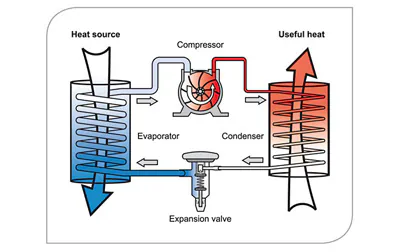Heat pumps and smart home integration are emerging as essential elements of improved energy efficiency and comfort in the ever-growing landscape of home technology. As we move into 2024, this combination of advanced systems is changing how we manage our homes. This blog explores how integrating heat pumps with smart home technology can improve efficiency, reduce costs, and increase overall comfort.
Understanding Heat Pumps
Heat pumps are versatile devices designed to transfer heat rather than generate heat. They work by extracting heat from the air, water, or soil and transferring it to your home. Unlike traditional heating systems that burn fuel for heat, heat pumps move electricity from one location to another. This process results in greater efficiency, especially in milder climates.
See Also Air Conditioning Maintenance Myths Debunked: What You Really Need to Know
Types of Heat Pumps
- Air Source Heat Pumps (ASHP): These are the most common type and extract heat from outside air. Both heating and cooling can be provided, making it a year-round solution.
- Geothermal Heat Pumps (GSHP): Also known as geothermal heat pumps, these systems transfer heat from the ground. They are more efficient than air source heat pumps but are generally more expensive to install due to the need for a floor loop.
- Water Heat Pumps (WSHP): These use water from a nearby source such as a lake or river to transfer heat. They are highly efficient but require proximity to a water source.
The Role of Smart Home Integration
Smart home technology has evolved rapidly, offering devices and systems that improve comfort, safety, and performance. Combined with a heat pump, smart home technology can dramatically improve the efficiency and performance of your heating and cooling systems.
See Also Ultimate Comparison: Gas Furnaces vs. Electric Heating Systems
Key Benefits of Integration
- Increased Efficiency: Smart thermostats like the Nest Learning Thermostat or Ecobee Smart Thermostat can make your heat pump more efficient by learning your settings and adjusting the temperature accordingly. This means your heat pump only runs when needed, reducing energy consumption and lowering utility bills.
- Remote Control: Smart home integration allows you to control your heat pump from anywhere using your smartphone or tablet. Whether you’re at work or on vacation, you can adjust settings, monitor your home’s performance, and make sure your home is at the perfect temperature when you arrive.
- Energy Management: Many smart thermostats come with energy monitoring features that give you insight into your energy usage. This data can help you identify patterns and make adjustments to further enhance performance.
- Automatic Scheduling: With a smart home system, you can create an automatic schedule for your heat pump based on your daily activity. For example, the system can lower the temperature while you’re away and raise it before you return, ensuring optimal comfort and efficiency.
- Integration with Other Smart Practices: The heat pump can be connected to other smart home appliances such as blinds, lighting systems, and climate controls that reduce cooling during the hottest part of the day. Smart weather sensors can adjust heat pump settings based on current weather conditions.
How to Integrate Heat Pumps with Smart Home Technology
- Choose a Compatible Smart Thermostat: Not all thermostats are compatible with every heat pump system. Ensure you select a smart thermostat that works with your particular heat pump model. Many modern heat pumps are designed to integrate seamlessly with popular smart thermostats.
- Install a Smart Hub: A smart hub acts as a central control point for all your smart home devices. It allows different devices to communicate with each other and provides a unified interface for control. Ensure your smart thermostat is compatible with your smart hub for seamless integration.
- Connect Your Devices: Follow the manufacturer’s instructions to connect your smart thermostat and heat pump. This typically involves syncing the thermostat with your home Wi-Fi network and configuring settings through a companion app.
- Set Up Automation Rules: Use the smart thermostat’s app to create automation rules. For example, you can set the thermostat to lower the temperature when the doorbell rings or adjust the heat pump’s settings based on weather forecasts.
- Monitor and Adjust: Regularly monitor the performance of your integrated system through the smart thermostat’s app. Make adjustments as needed to ensure optimal performance and efficiency.
The Future of Heat Pumps and Smart Home Integration
As technology continues to advance, the integration of heat pumps with smart home systems is expected to become even more sophisticated. Emerging technologies such as artificial intelligence and machine learning will enable heat pumps to learn and adapt to your preferences more accurately. Additionally, developments in renewable energy sources and smart grid technology will further enhance the efficiency and sustainability of heat pump systems.
See Also The Ultimate Checklist for Air Conditioning Installation in 2024
Conclusion
The integration of heat pumps with smart home technology represents a significant leap forward in home energy management. By combining the efficiency of heat pumps with the convenience and control offered by smart home systems, homeowners can achieve unprecedented levels of comfort, cost savings, and environmental responsibility. As we move through 2024, embracing this technology will not only enhance your home’s efficiency but also contribute to a more sustainable future.
If you’re considering upgrading your home’s heating and cooling system or integrating smart technology, contact KAC Express for expert advice and professional installation. Our team is dedicated to helping you achieve the perfect balance of comfort and efficiency.


0 Comments